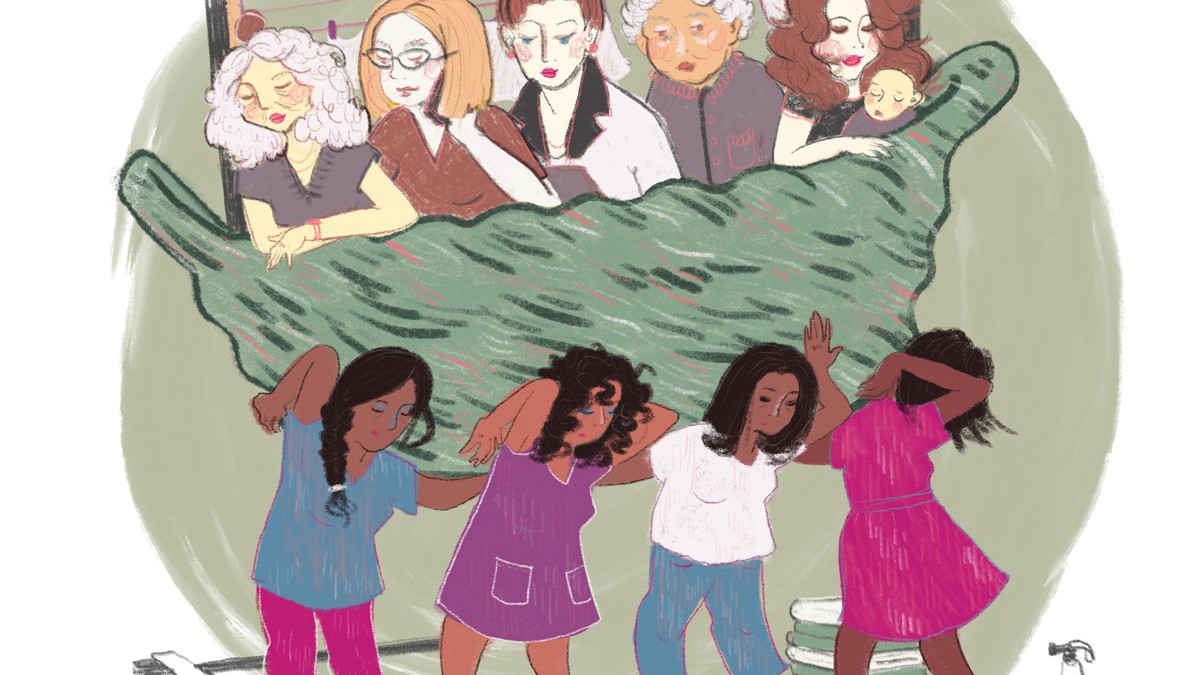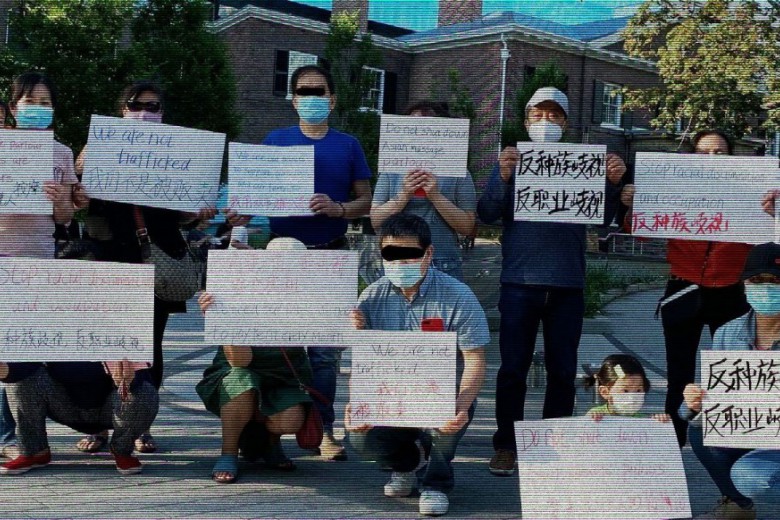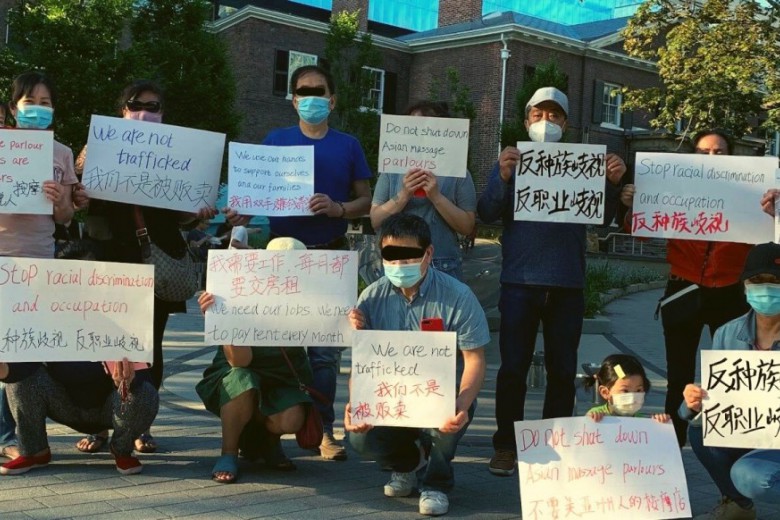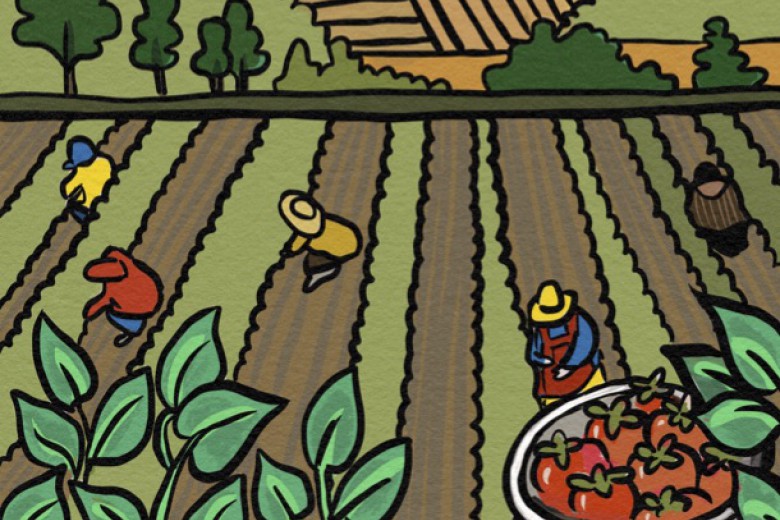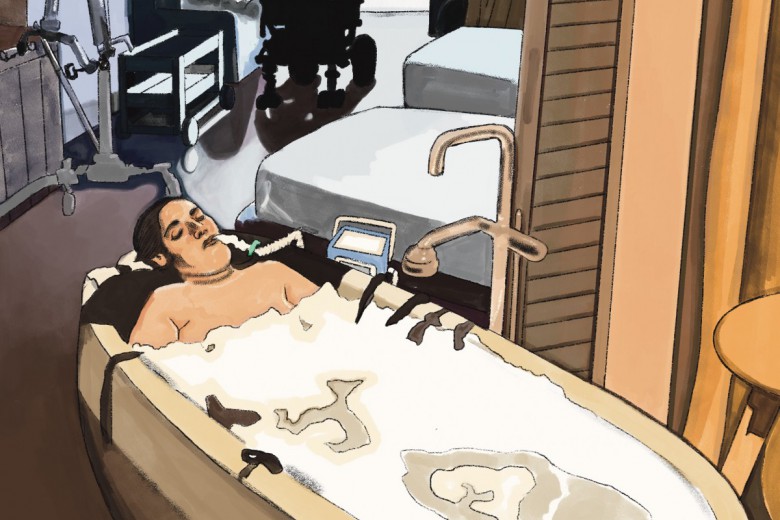Kara’s alarm clock barked in her ears at 6 a.m. Guess I’m going back to prison, she sighed to herself.
She went downstairs and cooked breakfast for three – the six-year-old boy with special needs she looked after, as well as his two parents, Kara’s employers – while packing three lunches and cleaning last night’s dishes.
Laundry, repairing the washroom sink, cleaning the bedrooms … Kara weighed her hefty workload for the day.
She tried but failed to finish repairing the sink before the boy came home from school. Within an hour the house was messy again – dishes clamouring to be washed and towers of dirty clothing. _Why fold your clothes when you can simply drop them for the nanny to pick up, right? _
All the while, Kara wondered if she might have some time to visit the doctor this week, since the walk-in clinic was closed on weekends. She had developed some odd spots in her eyes. “I need to see the doctor,” she relayed to the boy’s mother.
“I can’t miss my job just to be with my son,” her boss told Kara. “If you’re going to the doctor, who’s going to replace you?” So, that was that.
By the time she passed out on her bed, it was 10 p.m. Eight hours of pay for 16 hours of work. Should I talk to her about my hours?
Not long after, Kara woke to a text from her employer saying she was fired. “We don’t need you anymore. Don’t come back.”
The end of the Caregiver Program
Kara Manso, a trained nurse from the Philippines, migrated to Canada under the Live-in Caregiver Program (LCP) in 2012, only to find she was overqualified, overworked, and underpaid.
After five years as a caregiver in a federal immigration scheme advertised to be two years long, Manso finally got her permanent residency (PR). Every time she experienced employment violations or debasement, she remained resolute: “What’s a couple more months of all this trauma?”
Today, Manso is the coordinator of the Caregivers’ Action Centre in Toronto, an advocacy organization that empowered her to stand up to her employers during her time as a caregiver. She is no longer shackled to the distant possibility of PR, but is instead organizing a community of caregivers who, together, fight for transformative labour and immigration policies – like demanding that caregivers receive PR upon arrival in Canada.
“What’s a couple more months of all this trauma?”
On November 29, 2014, the federal government launched the Caregiver Program (CP), a five-year pilot project which replaced the LCP and removed the live-in requirement. In February the federal government posted on its immigration and citizenship webpage that the Caregiver Program will “expire on November 29, 2019.” Many caregivers were unaware that the CP was a pilot project, and were blindsided and frightened by the news of its impending end.
This means that if a caregiver isn’t able to complete her required 24 months or 3,900 hours of full-time work before that date, she will be ineligible for PR. A caregiver could be just days away from completing her hours by the cut-off date, and she may now feel even more pressure to acquiesce to poor working conditions or an abusive boss.
Caregivers across the country decided to use this threat as an opportunity. They have organized rallies, conducted petition drives, written reports, and held mass meetings, communicating their concerns to the Trudeau government during the government’s consultations this past April, to little response.
The government website insists that “The Government is committed to ensuring that caregivers continue to have a pathway to permanent residence,” but in the absence of a proposal or concrete plan, their words ring hollow to the caregivers, who have sacrificed everything for the promise of PR.
“Apartheid of citizenship”
Harsha Walia calls the Live-in Caregiver Program a form of “transient servitude” maintained by a system of “apartheid of citizenship.” To this, history can attest.
Some of the first immigrant caregivers were European women, recruited by the state and bonded to their employers, as industrialization at the turn of the 19th century propelled white settler women into occupations outside of domestic work. At first they hailed primarily from Britain and Scotland, and later from Eastern Europe, Germany, and displaced persons camps. This was a nation-building process: social reformers and middle-class women preferred female labourers they deemed to be of the “right” moral character – lower-income white women who could easily “belong” in settler society. These women were granted Canadian citizenship just as easily, giving them little incentive to continue working in the program after the end of their contract.
After the supply of domestic workers from European nations dried up, the Department of Immigration shifted its gaze southward to selectively and impermanently employ Black women from the Caribbean, namely Jamaica. The labour shortage persisted, however, as most of the Caribbean caregivers found their conditions to be unacceptable and would leave the sector once they completed their one-year requirement for PR.
Instead of addressing white Canadians’ unwillingness to take on the undervalued but highly essential role of care work, the government started issuing temporary work permits to Caribbean domestic workers in 1973. Regarded by migrant justice activists as a version of indentured labour, these workers were only granted the right to stay in Canada as long as they continued to work as caregivers.
Many caregivers were unaware that the CP was a pilot project, and were blindsided and frightened by the news of its impending end.
Today, the Caregiver Program allows for caregivers who have worked for 24 months or 3,900 hours within four consecutive years to apply for PR. But there’s no guarantee they’ll be granted it. Incoming caregivers – who, these days, mostly come from the Philippines – must prove often prohibitively high levels of English language proficiency, education, and work experience in Canada. Caregivers who complete the program are also subject to medical examinations, criminal and security screening, and other immigration-related fees.
For caregivers to change jobs or to begin working in Canada, they require a work permit. In order to get a work permit, employers must apply for and obtain a Labour Market Impact Assessment – a process that, on average, takes six months and costs employers $1,000 (the cost has almost quadrupled since 2014). Although this is the responsibility of the employer, and employers can face penalties for not complying, Manso, like many caregivers, had to shoulder half of this cost herself.
Manso waited for more than a year for her new work permit to be approved. “Many people end up working under the table,” she explains. “They need a caregiver, and we also need money to survive.”
In stark contrast to the era when poor white women were recruited as “nannies” and “governesses,” the past few decades have seen the state exerting ever more control over the lives of racialized caregivers. This is not a coincidence: in the face of a labour shortage for caregivers, Canada stands to avoid huge costs by hiring cheap external labour that is painted as “temporary” and “foreign.” Why invest in a domestic labour force when the government can outsource gendered labour to Filipina women, essentialized as “natural caregivers,” to whom they can deny political and social rights?
From past to present, the program has created a labour force that appears docile. Their precarious legal status deters caregivers from speaking out about abuse from their employers, or challenging government policies. As a result, today’s caregivers feel not only the pressure of state control, but also employer control, which is reinforced by lax provincial labour laws.
In 2014, the “live-in” component was removed and the Caregiver Program emerged. The change ostensibly limited overtime work, unpaid hours, and abuse – but it did not address the lack of access to PR or the structural powerlessness of caregivers as workers. Caregivers now also face further challenges in securing housing in expensive cities like Toronto, while often earning a minimum wage that fails to keep up with the cost of living.
“They need a caregiver, and we also need money to survive.”
At the same time, Stephen Harper’s Conservative government decided to create two separate streams: the “Caring for People with High Medical Needs” class and the “Caring for Children” class. Despite having no cap on the number of work permits issued in a given year, the Harper government only granted PR to a yearly maximum of 5,500 applicants – a practice that the Trudeau government continues. There was no such cap on the number of caregivers who could obtain PR under the Live-in Caregiver Program, which granted many more caregivers permanent resident status from 2006 to 2014. But as the demand for caregivers increases, the government has struggled to keep up with a growing backlog of PR applications for past and present caregivers – meaning most caregivers are still waiting years for their PR, which may never come.
What’s more, caregivers with advanced qualifications under the High Medical Needs pathway are being put through the wringer in their efforts to obtain PR. While these caregivers need to complete two years of full-time Canadian work experience to be eligible for PR, those under the Federal Skilled Worker class can apply for PR without any Canadian work experience, despite having the same skills. The government has constructed a deliberate and illogical hierarchy between immigrant classes based on whom it considers “skilled” workers. But it is also symbolic of the government’s disdain toward care work. As Canada’s population ages, this program uses precarious and underpaid migrant health professionals to prop up the existing quasi-privatized health economy, instead of fortifying a universal health-care system that should practise fairer employment standards.
To Manso, the division of Canada’s immigration streams reflects a core problem with Canada’s caregiver program: “They need to recognize caregiving work as real skilled work. Change the whole concept. […] Who tells anybody what’s low-skilled and high-skilled?”
Waiting, waiting, waiting to be reunited
Family is everything to Jasmine*, and it’s the reason she chose to leave her children – five, seven, and nine years old at the time – to migrate to Canada from the Philippines as a caregiver under the LCP in 2008.
Today, Jasmine lives in Orangeville, Ontario. She tells me, with some resignation, she is still “waiting, waiting, waiting, waiting” for her PR.
Jasmine, who has a bachelor’s degree in commerce and accounting, planned her entire life around the idea that she and her family would be able to attain PR in Canada after two years, as advertised in the LCP. In 2003, Jasmine applied to the program via a recruitment agency that charged her thousands of dollars to process her papers, finally allowing her to arrive in Canada five years later.
To complete the two-year program Jasmine worked through four employers, waiting for months in between to get new work permits each time. While Jasmine is more generous in her characterization of her employers than most, describing herself as “a fighter,” she uses a familiar metaphor. “You’re like a prisoner, but you’re not in a cell. […] I feel like I’m trapped,” she explains. Physically, mentally, emotionally, Jasmine feels drained and tells me that she is “under the mercy of the program.”
Jasmine has worked here for the past 10 years but is still waiting for PR. For those 10 years, she has been separated from her family members, one of whom – her daughter – has special needs. Although Jasmine’s husband took care of their children in the past, his recent death has forced the family to hire a 70-year-old Filipina woman to care for Jasmine’s children. This is illustrative of a “global care chain” in which people are linked across borders based on the unpaid or paid work of caring. The labour of other women – usually poorer and with more precarious status than their employers – fills the care deficit in each link of this chain.
“You’re like a prisoner, but you’re not in a cell. […] I feel like I’m trapped.”
On average, foreign caregivers in Canada are separated from their families for at least six years. For Jasmine, this number represents missed opportunities: “You know, you don’t have family, you don’t have children, your children grow up. I don’t spend Christmas, birthday for 10 years with them. […] I left them when they were in grade school, and now they’re in college, they have girlfriends. […] That’s why maybe I have a lot of aches, because I’m stressed, thinking, when are they coming here?”
Jasmine’s case intersects with another issue: the Canadian government deems individuals with special needs and/or disabilities as “medically inadmissible” if they place an “excessive demand” on the nation’s health and social services. Jasmine was one of the key migrant justice activists who successfully fought to increase the threshold for “excessive demand” in June of 2018. But still, Jasmine has been left hanging on her PR application. With disbelief in her voice, she tells me, “They would take my labour but they will not take my family.”
Despite years of adversity, Jasmine is undaunted. She tells me about the numerous times she has visited her member of Parliament and called Canada’s immigration department for answers, to little avail. Jasmine’s unwavering hope is tied to her faith in Canada as “one of the best countries to live in.” However, she also knows the reality: “Canada is known back home as a friendly country, very safe, which [is] true – but just this program, I don’t know about. This LCP is not really designed […] to make caregivers happy. […] So now people back home, they don’t know what’s been going on with us caregivers here. That’s why they keep coming here.”
Jasmine was accepted as a principal applicant in the Federal Skilled Worker class before she applied to the LCP, but she was not able to pay for it. Instead, she chose the LCP as a more affordable path to settling in Canada. To Jasmine and many others like her, Canada’s offer of permanent status is unique: other such programs in places like Hong Kong do not provide foreign domestic workers an opportunity to become citizens. Yet this is the carrot that Canada dangles in front of caregivers, while hiding the costs, uncertainty, and precarity of the process.
Whose labour counts?
Domestic work is labour, expected of women, that is typically un- or underpaid, undervalued, and invisible. However, in both normative and material terms, care work is the very backbone of our socio-economic fabric.
Low-income, racialized, migrant women have long been the primary groups who perform the labour necessary to care for individuals who may provide their own labour to the workforce and broader society – also known in Marxist feminist terms as “reproductive labour.” By capitalist measures, this is the very labour that allows individuals to become “productive” members of society. Racialized migrant caregivers’ labour has been essential for the upward mobility of white women, who can freely enter the labour market. Jasmine explains to me: “Without a caregiver, you cannot go to your work, yeah? No one will attend to your children, and no one will attend to your elderly.” By anti-capitalist measures, care work is essential to cultivating individuals who can grow to collectively contribute to their communities and, in turn, care for one another.
The labour of other women – usually poorer and with more precarious status than their employers – fills the care deficit in each link of this chain.
One would think that the persistent labour shortage of caregivers would be enough of a reason for the Canadian government to develop a long-term solution. However, the state has always preferred a privatized child-care system reliant on cheap racialized labour. In 1987, for instance, the Ontario government actively fought against overtime pay and fairer hours for domestic workers in the Employment Standards Act. Since then, the federal government has opted for piecemeal social policies, such as cash transfers and child-care tax credits. This approach compels middle- and upper-class families to find child care privately, through the market, in the form of home-based care that is typically low paid.
The Canadian government would prefer to subsidize a private child-care system that exploits migrant women of colour rather than invest in an affordable, universal, and equitable public care system. Meanwhile, the Canadian Centre for Policy Alternatives estimates that 776,000 children (44 per cent of all non-school-aged children in Canada) live in “child-care deserts,” where affordable licensed child care is scarce. Metropolitan cities, where many caregivers are employed, maintain some of the highest child-care costs – with Toronto being the most expensive. If the government of Canada is more motivated by nation-state races for social security, it should know that, out of 35 peer nations, Canada is the third most expensive country for child care – after only the U.S. and Ireland.
Reconstructing our care economy
There are several policy steps that Canada’s government can take to recognize the value of racialized migrant caregivers and equitably reconstruct our care economy: institute permanent resident status upon landing; implement a comprehensive and universal child-care program; and extend labour protections, including unionization, to home-based workers at the provincial level. All of this comes in the wake of the International Labour Organization’s 2013 Domestic Workers Convention, which Canada has yet to ratify. Migrant caregiver advocacy groups have been organizing around these issues for decades, and have won important incremental changes.
As caregivers and migrant workers enter into a significant year of their fight, Manso is hopeful. “It’s time for people across the country to start fighting with us, instead of against us,” she says. “We are women, we are queer, we are working class, we are Black and Brown, and we are leading the way. We will win.”
*Names have been changed to protect workers’ privacy.


